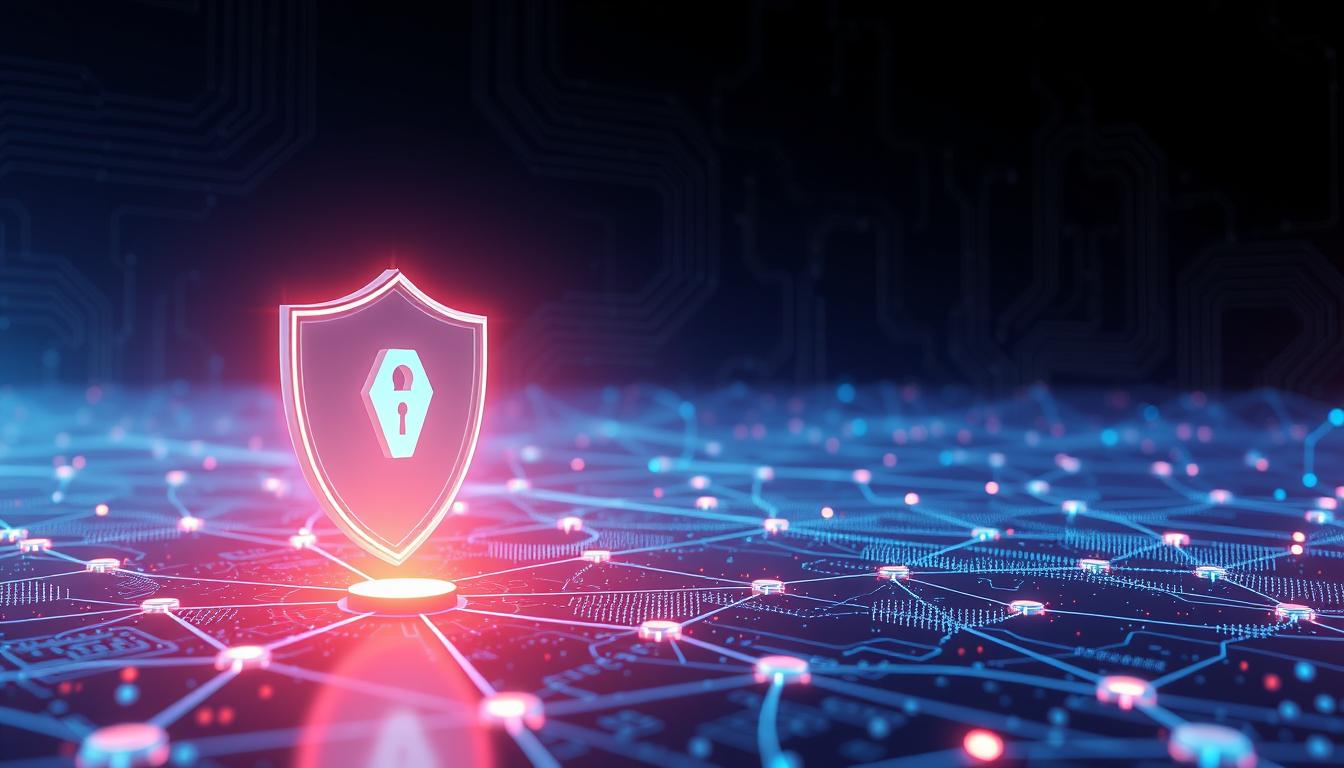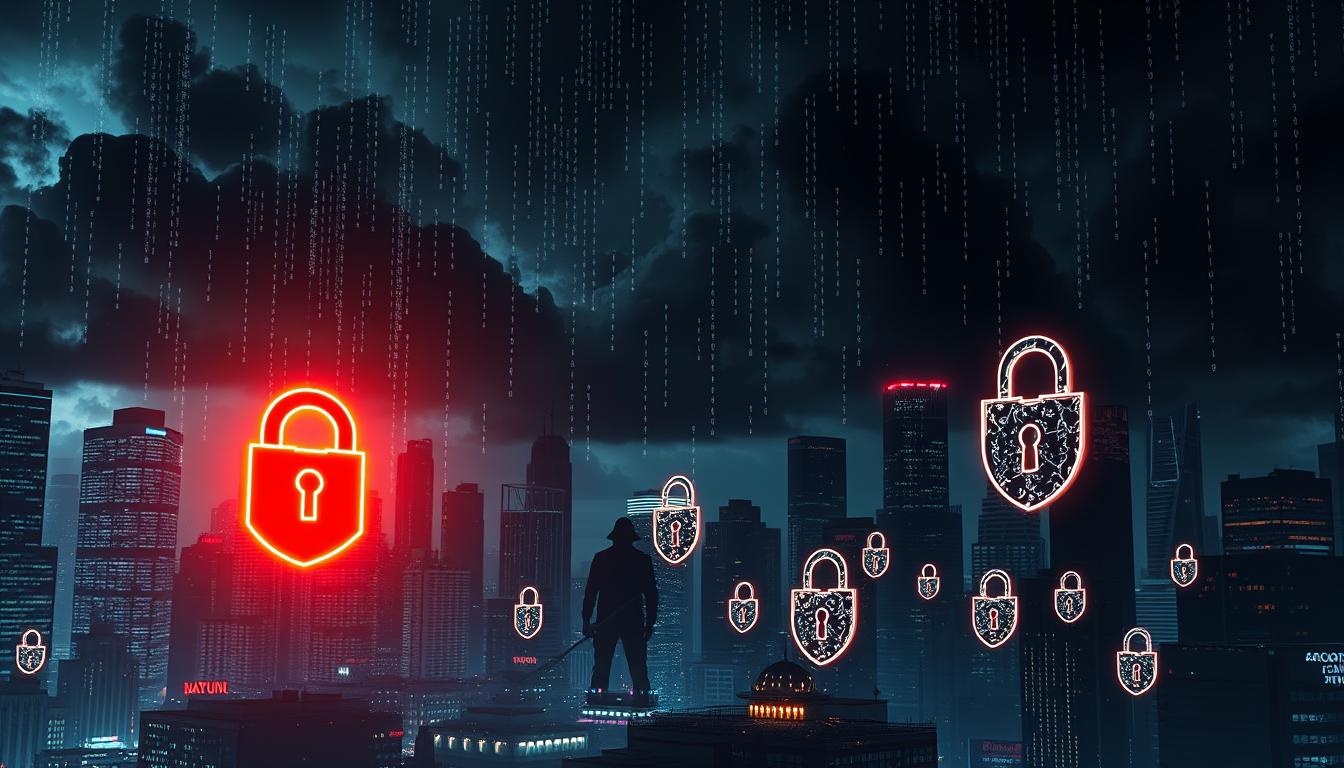Did you know that the global cybersecurity market is expected to grow to a staggering $304.91 billion by 2027? This surge in demand underscores the critical need for businesses to fortify their cybersecurity posture. At the heart of this effort lies the security operations center (SOC), a centralized command hub that plays a pivotal role in safeguarding organizations against evolving cyber threats.
In today’s digital landscape, where cyberattacks can cripple even the most robust enterprises, a well-designed and proactively managed SOC is no longer a luxury but a necessity. By establishing a security operations center, businesses can leverage real-time monitoring, threat detection, and incident response capabilities to protect their most valuable assets and ensure regulatory compliance.
Key Takeaways
- The global cybersecurity market is expected to grow to $304.91 billion by 2027, underscoring the critical need for businesses to strengthen their security posture.
- A security operations center (SOC) is the heart of an organization’s cybersecurity strategy, providing round-the-clock monitoring, threat detection, and incident response capabilities.
- By establishing a robust SOC, businesses can safeguard their critical assets, maintain regulatory compliance, and ensure the overall security of their operations.
- A well-designed SOC leverages real-time monitoring, threat detection, and incident response capabilities to protect against evolving cyber threats.
- Investing in a security operations center is no longer a luxury but a necessity for businesses in today’s digital landscape.
What is a Security Operations Center?
A security operations center (SOC) is a centralized unit that oversees an organization’s cybersecurity efforts. It serves as a command center, where security analysts and experts constantly monitor the network, detect and investigate security incidents, and coordinate the response to mitigate threats. The SOC leverages advanced technologies, such as security information and event management (SIEM) and security orchestration and automation (SOAR), to provide real-time visibility and rapid threat response.
Centralized Cybersecurity Command Center
The SOC acts as a central hub for an organization’s security operations, bringing together a team of highly skilled professionals who specialize in various aspects of cybersecurity. This includes security analysts, threat hunters, incident responders, and security engineers, all working collaboratively to protect the organization from cyber threats.
Real-time Monitoring and Threat Detection
At the heart of the SOC is its ability to continuously monitor the organization’s network, systems, and applications for any signs of suspicious activity or potential security breaches. By utilizing advanced security tools and analytics, the SOC can quickly identify and investigate threats, enabling a rapid and coordinated response to mitigate the impact of any security incidents.
| Key Features of a Security Operations Center | Benefits |
|---|---|
|
|
Why Your Business Needs a Security Operations Center
In today’s digital landscape, where cybersecurity risks are constantly evolving, businesses of all sizes must prioritize the protection of their critical data and assets. Establishing a Security Operations Center (SOC) is a crucial step in mitigating these cybersecurity risks and ensuring regulatory compliance.
Mitigating Cyber Threats and Risks
A Security Operations Center acts as a centralized command center, continuously monitoring your network and systems for cyber threat mitigation. By proactively detecting and responding to security incidents, the SOC can help your business avoid the devastating consequences of data breaches, financial losses, and reputational damage.
- Real-time threat detection and analysis
- Prompt incident response and investigation
- Vulnerability identification and remediation
Ensuring Regulatory Compliance
In many industries, compliance with regulatory requirements is not only crucial for maintaining the trust of your customers but also essential for avoiding hefty fines and legal penalties. A well-designed SOC can help your business stay ahead of the curve, ensuring that your cybersecurity practices meet or exceed the necessary standards.
“Cybersecurity is no longer an option, it’s a necessity. A Security Operations Center is the foundation for protecting your business in the digital age.”
By investing in a Security Operations Center, you can safeguard your organization’s future, protect your valuable data, and maintain the confidence of your clients and stakeholders.
Key Components of an Effective Security Operations Center
Establishing a robust security operations center (SOC) is crucial for safeguarding your business against the ever-evolving cybersecurity threats. An effective SOC is a centralized hub that combines advanced security tools, automated processes, and a team of skilled professionals to provide comprehensive protection. Let’s explore the key components that make an SOC truly effective.
At the heart of an SOC are the security tools and technologies that enable real-time monitoring, threat detection, and incident response. These include security information and event management (SIEM) systems, security orchestration and automated response (SOAR) platforms, and other specialized security analytics tools. These components work together to gather, analyze, and correlate security data from across the organization, allowing the SOC team to identify and address security incidents quickly.
Complementing the technological aspects are the security processes and procedures that guide the SOC’s operations. These include well-defined incident response plans, threat hunting protocols, and vulnerability management strategies. These processes ensure that the SOC team can respond effectively to security events, minimize the impact of breaches, and proactively identify and address potential vulnerabilities.
Finally, the SOC relies on a team of highly skilled security professionals, including analysts, engineers, and threat hunters. These individuals collaborate closely to monitor, investigate, and mitigate security threats, leveraging their expertise and the available security tools and processes to protect the organization.
| SOC Component | Description |
|---|---|
| Security Tools and Technologies | SIEM, SOAR, security analytics tools, and other specialized security solutions |
| Security Processes and Procedures | Incident response plans, threat hunting protocols, vulnerability management strategies |
| Security Professionals | Security analysts, engineers, and threat hunters |
By integrating these key components – security tools, processes, and a skilled team – an effective security operations center can provide your business with the comprehensive protection it needs to mitigate cyber threats and ensure the continuous security of your critical systems and data.
Security Information and Event Management (SIEM)
At the heart of an effective Security Operations Center (SOC) lies a synergistic combination of security information and event management (SIEM) and security orchestration and automation (SOAR) technologies. These powerful tools work in tandem to provide organizations with a comprehensive, data-driven approach to cybersecurity.
Security Information and Event Management (SIEM)
SIEM systems serve as the central nervous system of the SOC, collecting and analyzing security-related data from across the organization. By aggregating information from various sources, SIEM platforms offer a unified view of the threat landscape, empowering security teams to proactively identify, investigate, and respond to potential security incidents.
Security Orchestration and Automation (SOAR)
Complementing SIEM’s analytical capabilities, SOAR solutions automate and orchestrate the incident response process. These advanced tools streamline workflows, allowing the SOC to quickly and efficiently address security events. By integrating SIEM and SOAR, organizations can enhance their overall security posture, reducing response times and improving the effectiveness of their cybersecurity efforts.
The seamless integration of SIEM and SOAR technologies within the SOC setting provides organizations with a powerful and intelligent approach to security management. By leveraging the strengths of these solutions, businesses can gain deeper insights, optimize their security operations, and stay one step ahead of the evolving threat landscape.

“The combination of SIEM and SOAR empowers security teams to be more proactive, responsive, and effective in protecting against cyber threats.”
Incident Response and Threat Hunting
In today’s rapidly evolving cybersecurity landscape, a robust Security Operations Center (SOC) plays a vital role in swiftly detecting, investigating, and responding to security incidents. The SOC’s incident response protocols and threat hunting capabilities are essential for safeguarding your business from the devastating impacts of cyber threats.
Rapid Incident Response Protocols
When a security incident occurs, time is of the essence. The SOC’s well-defined incident response protocols ensure a coordinated and efficient response, minimizing the damage and disruption to your business operations. These protocols outline the steps to be taken, from initial detection and analysis to containment, eradication, and recovery.
The SOC’s incident response team is trained to quickly mobilize, triage the incident, and execute the necessary actions to mitigate the threat. By leveraging security analytics and automated incident response workflows, the team can rapidly identify the root cause, contain the incident, and restore normal operations with minimal downtime.
Proactive Threat Hunting
In addition to reactive incident response, the SOC’s threat hunting capabilities enable security analysts to proactively search for and identify potential threats within your network. By employing advanced security analytics and threat intelligence, the SOC can uncover hidden indicators of compromise and respond to emerging threats before they can cause significant harm.
Threat hunting goes beyond traditional security monitoring, as the SOC actively seeks out and investigates suspicious activities, hunting for signs of advanced persistent threats, insider threats, and other sophisticated attacks. This proactive approach enhances your organization’s overall security posture and helps to prevent damaging security breaches.
| Incident Response | Threat Hunting |
|---|---|
| Rapid detection and response to security incidents | Proactive search for potential threats within the network |
| Minimized impact and disruption to business operations | Identification of advanced persistent threats and other sophisticated attacks |
| Coordinated and efficient incident management protocols | Improved security posture and prevention of security breaches |
By combining incident response and threat hunting capabilities, the SOC becomes a powerful force in safeguarding your business against the ever-evolving threat landscape. This holistic approach empowers your organization to stay one step ahead of cyber criminals and maintain the integrity of your critical systems and data.
Vulnerability Management and Patching
Maintaining the security of your business operations is a top priority, and effective vulnerability management is a crucial component of this effort. In the dynamic world of cybersecurity, proactively identifying and addressing vulnerabilities is essential for minimizing the risk of successful cyber attacks.
A well-designed security operations center (SOC) continuously monitors the network for potential vulnerabilities, assesses their risk, and coordinates the timely deployment of security patches to address them. This proactive approach helps to reduce the organization’s attack surface and ensures compliance with industry regulations, ultimately enhancing the overall resilience against cyber threats.
Prioritizing Vulnerability Management
The SOC team utilizes advanced vulnerability scanning tools and techniques to identify and assess the severity of vulnerabilities across the entire network. By prioritizing the most critical vulnerabilities based on factors such as the potential impact and exploitability, the team can focus their efforts on addressing the most pressing risks first.
Coordinating Patching Efforts
Once vulnerabilities are identified, the SOC team works closely with IT and development teams to coordinate the deployment of security patches. This process involves testing the patches to ensure compatibility and effectiveness, and then rolling them out in a controlled and systematic manner to minimize disruption to ongoing business operations.
- Continuous vulnerability scanning and assessment
- Prioritizing critical vulnerabilities based on risk
- Coordinating the testing and deployment of security patches
- Ensuring timely and effective patching across the organization
- Maintaining compliance with industry regulations and standards
By proactively managing vulnerabilities and maintaining a robust patching strategy, the SOC plays a vital role in safeguarding the organization’s assets, reducing the risk of successful cyber attacks, and ensuring compliance with regulatory requirements.
Security Analytics and Reporting
The security operations centre (SOC) leverages advanced security analytics to gather, analyze, and interpret data from various security tools and sources. This data-driven approach provides the SOC with valuable insights, enabling security teams to make informed data-driven decision making and optimize security controls, thereby improving the overall security posture management of the organization.
Comprehensive reporting generated by the SOC helps executives and stakeholders understand the organization’s security risks and the effectiveness of the implemented security measures. These reports offer a clear and concise overview of the security landscape, empowering decision-makers to allocate resources more efficiently and develop effective strategies to enhance the overall security of the business.
Actionable Insights for Better Decision-Making
The SOC’s security analytics capabilities enable the security team to identify patterns, trends, and anomalies in the data, which can then be translated into actionable insights. By leveraging these insights, organizations can make more informed decisions, proactively address potential threats, and enhance their overall security posture.
The combination of security analytics and comprehensive reporting provides the SOC with a powerful tool for data-driven decision-making. This approach allows organizations to stay ahead of evolving security threats and ensure continuous improvement in their cybersecurity efforts.
| Key Benefits of Security Analytics and Reporting | Description |
|---|---|
| Improved Threat Detection and Response | Identify and respond to security incidents more effectively by analyzing data from various security tools and sources. |
| Enhanced Security Posture Management | Gain a deeper understanding of the organization’s security vulnerabilities and implement targeted security measures to mitigate risks. |
| Informed Decision-Making | Make data-driven decisions to optimize security controls, allocate resources more efficiently, and develop effective security strategies. |
| Improved Regulatory Compliance | Generate comprehensive reports to demonstrate compliance with relevant industry regulations and standards. |
By leveraging the power of security analytics and comprehensive reporting, the security operations centre can provide the organization with the insights and tools necessary to make informed, data-driven decision making and enhance the overall security posture management of the business.
Conclusion
Establishing a security operations center is a critical step for businesses of all sizes to safeguard their assets, maintain regulatory compliance, and ensure the overall security of their operations. By centralizing cybersecurity efforts, leveraging advanced technologies, and employing skilled security professionals, the security operations center provides round-the-clock monitoring, threat detection, and rapid incident response capabilities.
As the threat landscape continues to evolve, a well-designed and effectively managed security operations center can be the cornerstone of an organization’s cybersecurity strategy, protecting its critical resources and preserving its reputation. By implementing a robust security operations center, businesses can mitigate cyber risks, ensure compliance with industry regulations, and ultimately, enhance their resilience in the face of ever-changing security challenges.
Investing in a security operations center is a prudent decision for organizations that prioritize the security and continuity of their operations. By leveraging the expertise, technology, and processes of a dedicated security operations center, businesses can safeguard their assets, maintain customer trust, and thrive in an increasingly complex digital landscape.



